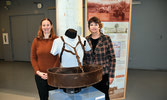By Lisa Boonstoppel-Pot
Agriculture has and continues to make a huge impact on Bruce County which is why the Bruce County and Cultural Museum wanted to teach and celebrate agriculture with their new exhibit called Farm Fresh.
“Our agricultural past is part of who we are as a people,” says Cathy McGirr, Director of Cultural Services. “Agriculture is historical, economical and cultural.”
The Farm Fresh exhibit fills one of the large temporary galleries at the museum and examines how agriculture fostered strong community bonds while building the economy of Bruce County. The exhibit also examines farming technologies, life on the farm, off-shoot industries, community groups and changing trends in the business of agriculture. It also examines Indigenous farming practices.
Curatorial Assistant, Laura Leonard, explained that some of the off-shoot industries include grist mills. Back in the day, Walkerton had one of the few grist mills and if you were farming in Southampton (where the museum is located) it would literally take days to travel and wait for your wheat to be ground into flour.
“You would hook up the oxen, put the grain in the wagon, and travel in the winter (because winter “roads” were best for travel) to get your flour, explains Leonard. “It’s mind-boggling that to make your loaf of bread, you had to be away from home for sometimes a month to get your grain ground.”
Farm Fresh does have artifacts from the Tara Milling Company which was open between 1857 and 1953. Leonard said that flour mills had an unfortunate tendency to catch fire and that’s what eventually destroyed the Tara flour mill.
Another intriguing exhibit is that turkey egg incubator that was heated with a kerosene lamp. Looking at it brings back memories of hatching chicken eggs for McGirr. “My mom used to take the chicken eggs that weren’t hatched and put them in a box on the oven door.”
McGirr said that’s part of the purpose of a museum exhibit – to unleash memories, long buried and recall family times growing up on the farm, or visiting a grandparent’s farm.
The exhibit also tracks the trajectory of farming from when pioneers had to cut down trees to clear land, to families depending on each other to survive the winters to establishing mixed farms where the goal was to feed yourself, and sell what you had left over.
“It’s so very different from today’s farms that are hundreds or thousands of acres with the sole purpose of selling products,” says Leonard.
An old plow called the Scottish Swing Plow is another artifact at the Farm Fresh exhibit that draws curiosity. Contributed by the McDonald family, it was imported in 1852 by James “Red Jim” McDonald. His grandson, George, would later win the Bruce County Plowmen’s Association Trophy for the best single furrow with a plain plow at the first Bruce County Plowing Association competition held outside Paisley in 1924.
Another curious item is a pan with straps that was used to broadcast seed. “If you didn’t have a seeder, that was the best way to do it,” says Leonard. This particular pan had a harness that was ergonomically designed before that phrase became popular, allowing the farmer to wear it for many hours planting his field.
The exhibits also include displays of pamphlets and materials from such important agricultural social societies, movements, and supports as the Farm Forum, Queen’s Bush Ministries and local fall fairs.
“Visitors like to see the names because essentially, fall fairs are all about people,” says McGirr. “There are prizes for things like the best pie and the best cow. But it’s about connecting to your own ancestry. If you see a butter churn here, you might remember seeing one in your grandparents’ house and that keeps the farm connection for your family alive.”
There are over 60 artifacts in the exhibit. Plus, the display features companion pieces from Archives Ontario’s Fresh from the Farm exhibit.
McGirr said the exhibit is being used by teachers in the area to teach students about historical farming methods and the benefits of community.
The next goal is to digitize the display so that anyone with mobility issues who cannot visit the museum, or people from other countries, can view the historical artifacts depicting farming’s past.
McGirr encourages people to come visit, adding the museum isn’t a dry, dark place to go. “This is an accessible, hands-on museum,” she says. “It’s not stagnant…it’s a dynamic site and a happy place!”
The space will next be used for a Made in Bruce exhibit which will launch in mid-January.
“Made in Bruce is a story about innovation, the kind which doesn’t happen in urban centres,” says McGirr. “A lot of it was born out of necessity.” ◊


